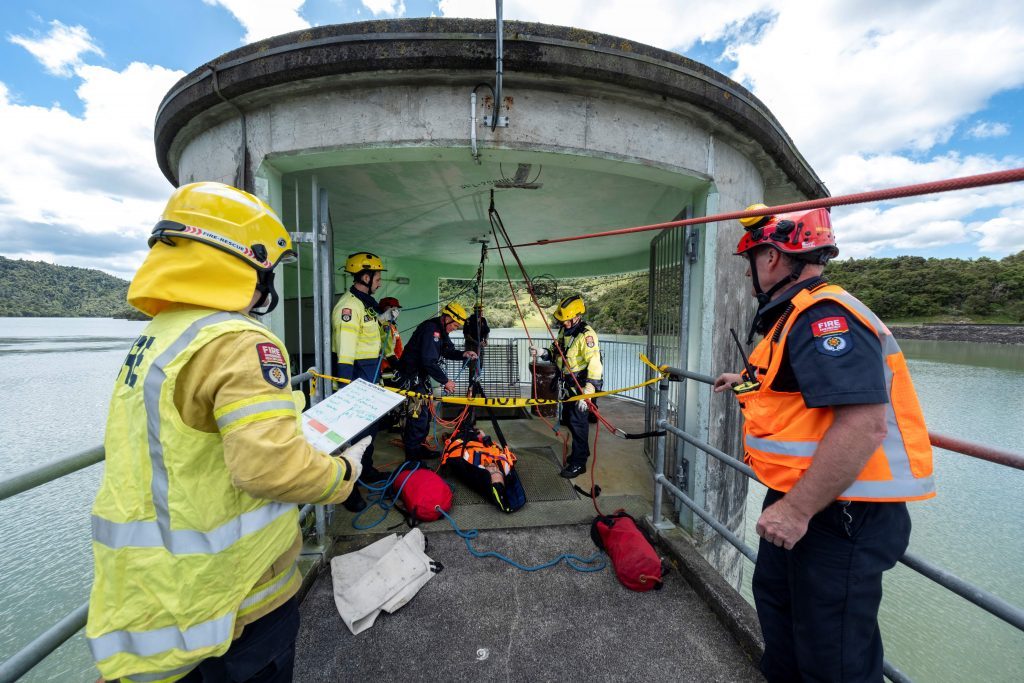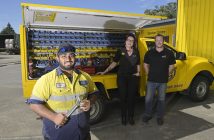This summer, Fire and Emergency New Zealand’s specialist high angle rescue team was called in to ‘rescue’ a Watercare staff member from the Wairoa Dam valve tower in the Hūnua Ranges

Auckland’s water and wastewater service provider Watercare has been working closely with emergency services to put its rescue plans to the test before they’re needed.
Watercare headworks manager James Talbot says the exercise – which was months in the planning – was designed to test the team’s valve tower rescue plan through all its stages.
“A valve tower is the structure that allows water from our lakes to enter the raw water pipelines. It contains valves and pipework that attach to a series of intake screens, and the Wairoa valve tower is 43 metres high, with six levels.
“Normal access into the tower is by a series of ladders. If someone can’t use a ladder, it becomes quite challenging to get them out.”
The tower’s remote location and thick concrete walls mean there’s no form of communication from inside, so whenever someone goes in by themselves, they must call in to say what they’re doing and when they’ll come out.
“If they haven’t come out by the specified time, we initiate a response to find out if they’re ok or if there’s an incident. If we can’t get hold of them, we send another team member to see if they can find them. If a rescue is required, we would then call the emergency services,” Talbot says.
The exercise started with a 111 call after Watercare dam technician Hēmi McGuinniety volunteered to be rescued.
“He had put together the logistics of the exercise and was keen to get first-hand experience of the rescue from the patient’s perspective,” Talbot says.
Fire and Emergency assistant commander Brendon Irwin says fire crews attended from Hūnua, Ōtara, Papakura and central Auckland.
“When Watercare first approached us as part of their emergency response plan we jumped on board and saw it as a really good opportunity for us to test our procedures as well.
“It grew some legs, which was great. Normally we’d just involve our Papakura crew, but we extended it a bit further and had our Hūnua volunteers as well – they were the first responding truck.
“We also got Auckland Westpac Rescue Helicopter involved as well. They transported our specialist lines rescue team from Auckland City – we generally try to put them on a helicopter when the rescue is more than 45 minutes away from town, where they’re based.
“A number of our fire crews have the ability to go down on a rope to a patient. Our specialist lines team has the ability to bring them up again.”
Talbot says it took just over three hours from the 111 call to the ‘patient’ being rescued, due to the remote location and technical nature of the extraction.
“We’re really happy with the response and how smoothly it went. We’ve done rescue exercises before but not on this scale and we hadn’t tested the full response,” Talbot says.
“The procedures worked well but there were learnings too. We’re now much more conscious of where we park our vehicles when we’re at the valve towers because if there is an emergency, the fire trucks need a lot of space. We can also look at how we could modify the valve towers to make it easier for Fire and Emergency to carry out a rescue.”
McGuinniety’s feedback was that it was cold waiting in the tower, which emphasised the importance of wearing layers to stay warm.
Irwin says the exercise was also a good training opportunity for the Fire and Emergency team.
“It went really well. There were a couple of things that stood out, from our perspective and for Watercare, but that’s why we test these plans. Now, if the real thing drops, we’re all better prepared for it.
“We’re doing more and more of these sorts of exercises with outside agencies, and they’re really valuable. Whakawhanaungatanga – building connections – is so important in breaking down barriers.”
Fire and Emergency New Zealand also works closely with Watercare’s Ardmore Water Treatment Plant team on scenarios that practice the response to a chlorine gas leak.
A rescue scenario held at Watercare’s Māngere Wastewater Treatment Plant last year trialled a new scaffold structure for use in deep tank rescues.
Rescuers strapped the ‘victim’ – a pair of overalls filled with about 80kg of sand – to a stretcher and carried it up the new scaffold structure to get out of the 8m-deep tank.
The trials went well and an improved version of the scaffold structure – with wider stairs to help get a stretcher around corners – has since been on standby while one of treatment plant’s reactor-clarifiers underwent maintenance.
Watercare head of production Peter Rogers says that while no one ever wants to receive a report that someone has been injured, it is important that staff are appropriately trained and prepared for such an event.
“These simulated events are invaluable as they enable staff to practice response procedures and find gaps where improvements can be made. Having the support of emergency services really amplifies the value of the training exercise, and this is definitely something we’ll be doing more of across our different sites.”







